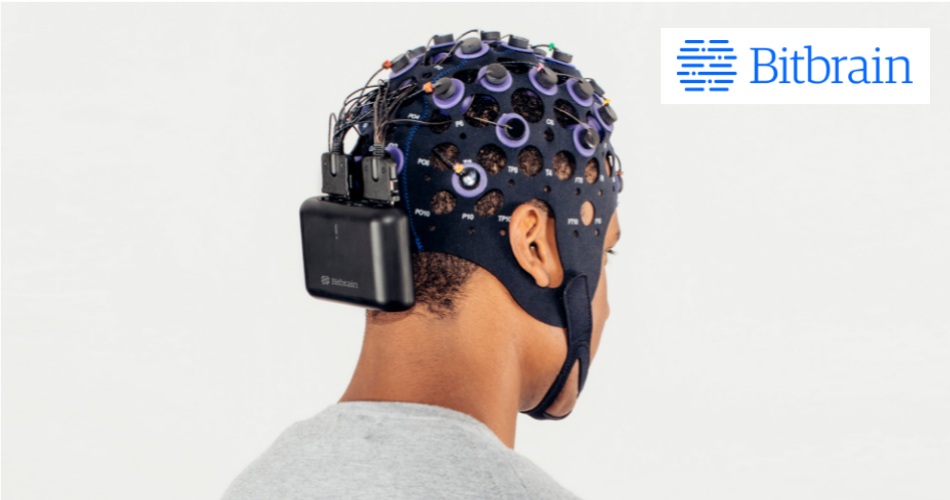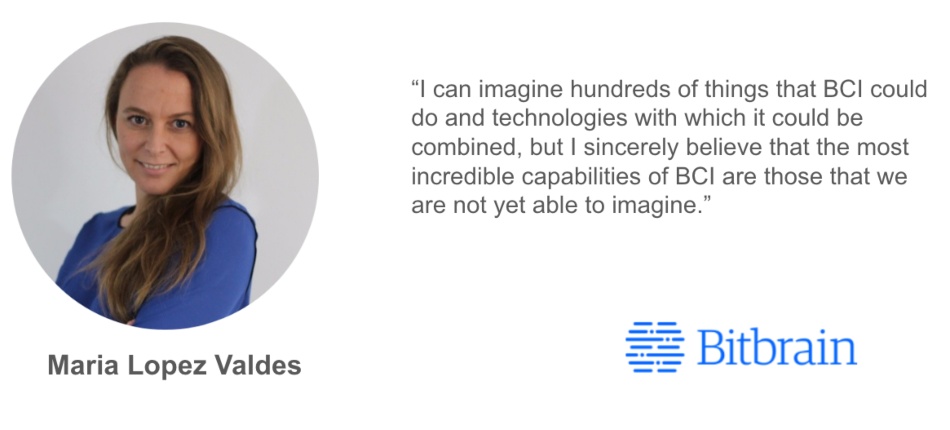

Freelance Life Sciences journalist supporting technological and scientific solutions through content creation and international expansion.
Are brain computer interfaces going to change the world? They carry amazing promises, innumerable applications but with privacy risks too. What will be the next steps to develop them? How will the BCIs look in a few years? We get a better understanding of this emerging market with Dr. María López, co-founder and CEO of one the leading companies in neurotech worldwide, Bitbrain, located in Zaragoza (Spain). María shares her sharp vision from both the research and business development sides and her passion about everything related to neuroscience and improving people’s lives through impactful science.
There are multiple ways to push this forward, but we believe the next breakthrough will be a combination of new sensors and new data processing. Although this may happen in different ways, we are currently focused on improving the quality of the signal (i.e., the sensor technology) and massively increasing accessibility and data.
As of today, they work at different scales and face different technological challenges. Invasive still involves much higher risks, although recent developments are really promising. Non-invasive still needs to break this ceiling that prevents it to become a serious alternative to control. However, non-invasive can be really the first option in many applications where control is not the main purpose, such as closed-loop interventions using biofeedback. There is space for both technologies in the next years.

Yes, plenty of them. We are currently involved in several initiatives to modify how we sense electric brain activity. This problem is being approached from different angles: improving the signal-to-noise ratio and the reliability of the recordings, reducing costs as well as the ecological footprint to allow massive scale-up, and improving comfort and acceptance by the user. To achieve this, we are looking into new materials such as textile or organic electrodes. We are working as hard as possible to bring some of these advances into our products in the next few years.
Neural disorders as the ones you mention have a huge impact on people’s life quality. Wearing and using BCI devices is still not as easy and wearable as to say an apple watch or other similar devices in health and wellness. People still need a strong reason and motivation to use them. To unlock all the potential in future applications, we will also need to address these aspects which can be a big stopper. Notwithstanding, every successful step forward is always good for the field.
I think Neuralink has set itself a very ambitious challenge (perhaps too ambitious) bordering on what is ethical and what is not. Developing invasive technology to help people who have brain disorders is within what is ethically acceptable (just like when a person needs a pacemaker). Using neurotechnology to connect our brain to the cloud and achieve a hybrid between a human being and artificial intelligence, is more dubious. From my point of view, it should be up to society (and not a private company) to decide whether it is acceptable or not. Moreover, this approach clashes with one of the neuro-rights that the scientific community defends, the right to personal identity. Such developments, if carried out, would be modifying our very human nature.
We have already seen some SCI patients walking thanks to an implant. Basic tasks that we perform in our everyday life are the ones that would really impact patient’s life quality. Washing your face, brushing your teeth, opening a door, walking to another room … those ones are really difficult but, again will make a huge impact on the lives of paralyzed people and their families. Hopefully, during 2022 we get to see some of these applications in patients’ homes and not only in controlled environments of research laboratories.
We do not always understand politicians and their decisions. Do their brains work like ours? Would BCI work on them? Joking aside, the potential of neurotechnology is incredible. It is deep tech, so it can have a profound impact on the way we live, work and relate to each other. It can be used to understand how we behave or how things affect us, to interact with machines or even to improve our brains. But again, great opportunities always come hand in hand with great challenges. The next few years are going to be exciting in the industry and I hope we remain responsible with the decisions that are made regarding this technology.
Technically, social media does not change our brain, it is the use we make of social media that can change it. And this happens with everything… Our brain is a learning organism with the ability to change depending on how you use it.
What makes the difference with BCI is that we could use it to make changes in our brain to our liking and much faster. As for the dangers involved, there is a clear privacy danger. Right now, we already have that problem with many other technologies. If someone could access data from our brain it could mean that they can know things about us that we don’t want to share or even access non-conscious thoughts that regulate our behavior that we are not even aware of. In any case, this would be in the hypothetical case that we would be able to decode thoughts and that, for the moment, is far from what we are currently capable of doing.
We are confident that over time BCI equipment will become more wearable and user-friendly to ease day-to-day tasks. It is possible that another type of technology might be developed capable of accessing information from the brain without even needing to wear a cap. As for price, as soon as BCI breaks into mass consumption, we will see a drastic price reduction. Right now, for the technology to work properly, it is necessary to use components that come from the clinical field and that comes with a high cost. However, prices will fall as soon as the economies of scale are introduced. In terms of capabilities, I can imagine hundreds of things that BCI could do and technologies with which it could be combined (virtual or augmented reality, 3D printing, etc.), but I sincerely believe that the most incredible capabilities of BCI are those that we are not yet able to imagine.
Such applications are being worked on and we are learning how the brain can be synchronized with certain activities. Again, it is still very early days, and we are in the very early stages of research in these fields, so it is difficult to distinguish between what will be possible in the short to medium term and what is more science fiction.
Since we founded Bitbrain in 2010 we have been very clear on wanting to bring neurotechnology closer to society. Since then, we have focused on developing highly reliable wearable equipment so that researchers can take their work out of the lab and bring it closer to real applications. We have also made developments for non-experts. For example, we collaborated with Nissan to develop the first Brain-2-Vehicle prototype that was used by thousands of people at CES 2018. We also developed a whole neuromarketing platform that is being successfully used by people who had never used neurotechnology before.
At a technology level, we are very focused on trying to reduce equipment costs without giving up reliability and ease of use. Additionally, we are establishing partnerships with other companies that are also interested in bringing neurotechnology closer to society.
Regarding application, we are very interested in developing solutions in the field of health that can be used at home. Given the high prevalence of brain disorders in society (dementia, sleep disorders, stroke, etc.) and the saturation that health systems have due to this, being able to bring diagnostic tests or interventions to patients’ homes so that they can perform them themselves can mean a drastic reduction in waiting lists and an exponential increase in the number of patients who can be treated.
The biggest impact Bitbrain can have is to really be able to accelerate the adoption of neurotechnology. In this sense, we are aware that the fastest way to achieve our vision is through collaboration. From Bitbrain we cannot address all applications, not even within the healthcare domain which is the one we are most interested in. So, to achieve our vision, we are collaborating with other companies and universities to complement us in health and be able to provide our technology to develop applications in other industries.
In over more than 10 years as a company, there are many cases that make us feel proud. For example, the collaboration with Nissan mentioned above is one of them, but without a doubt, the cases that make us most proud are those that have to do with health. For example, getting a quadriplegic person who cannot move one arm to be able to autonomously carry a spoon to his mouth thanks to our technology. Using our technology to cognitively improve people with mild cognitive impairment. Or developing neurotechnology that can be easily put on with one hand by someone who has never worn a similar device. The latter opens the door to autonomous neurorehabilitation at home for stroke patients.
I think there is a certain hype in the BCI industry now. Many start-ups are emerging that promise developments with a very powerful unique selling proposition, but with a very limited scientific base and without people in their teams capable of making those developments. We have had the opportunity to collaborate with some Venture Capital funds to evaluate the viability of some of these ideas, and the results are not always satisfactory. So, while it is true that investors can greatly accelerate the adoption of neurotechnology, they need to be able to select the start-ups that are most likely to succeed. And success is not just a matter of having a fantastic business idea (which is important), but of it being technically feasible.
© 2021 Insciter. All rights reserved. Insciter is a technology application which serves as a search engine and data provider
Trading name of Layer IV Limited. Registered in England and Wales No. 11737675